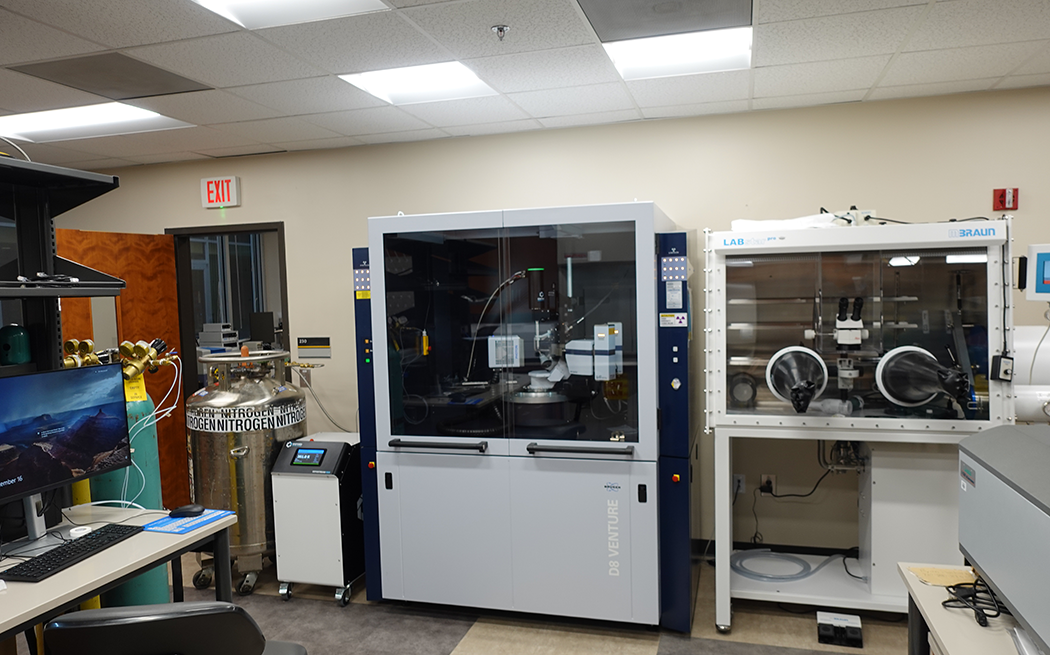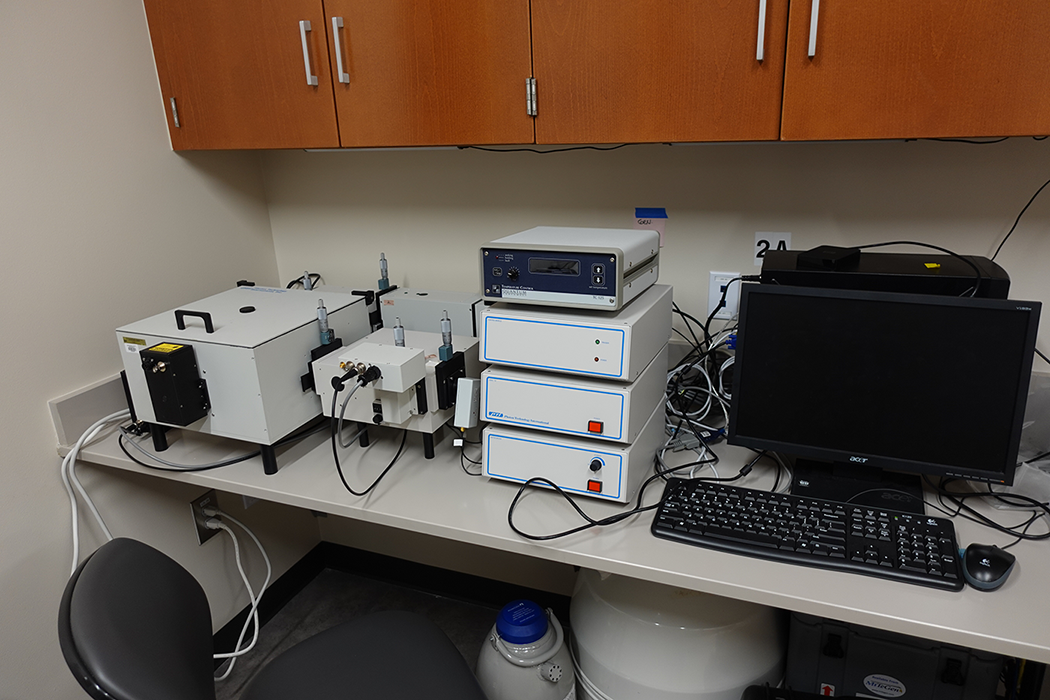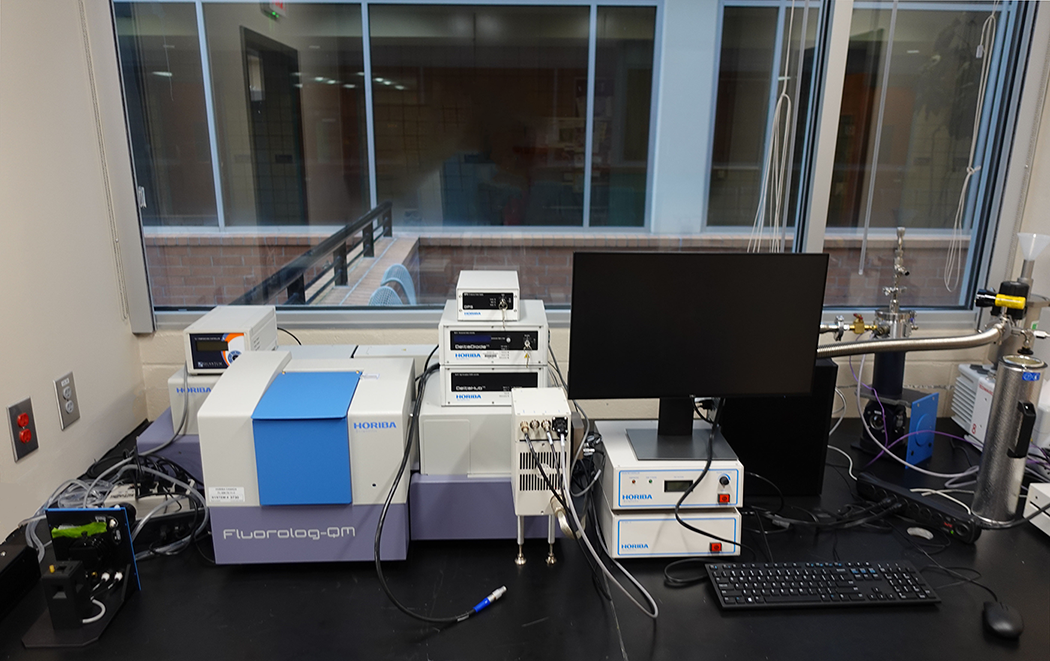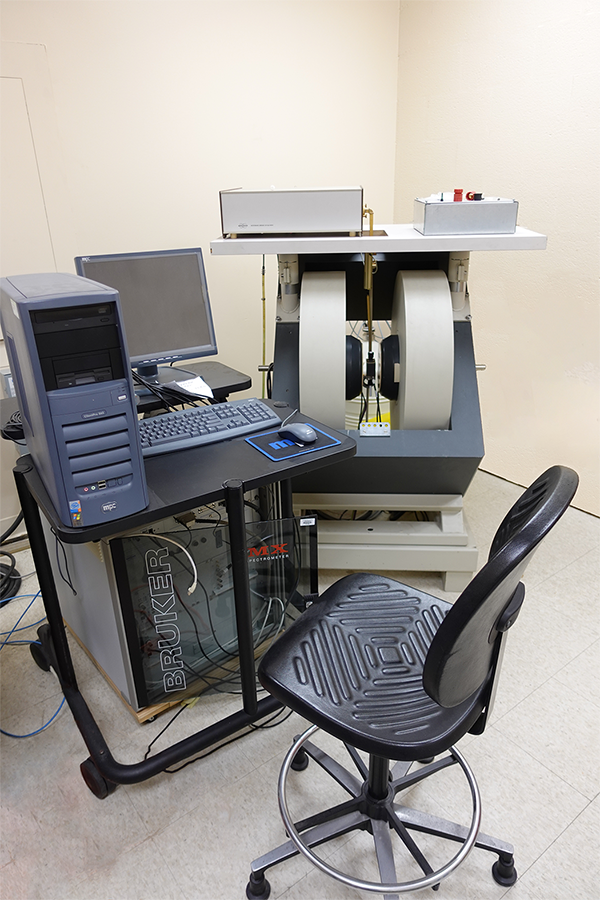Facilities
The College of Science and Mathematics has made significant recent investments in the research infrastructure. The Stollenz Group has unlimited access to the core and shared facilities. We also operate and administer the XRD diffractometers and spectrofluorometers of the Department of Chemistry and Biochemistry, located in the refurbished instrumentation lab SC 231 of the Science Building, two levels below Stollenz’s research labs.
X-Ray Diffraction Laboratory (SC 231)
Bruker Venture

The laboratory houses a Bruker Venture dual source (Mo and Cu radiation) single-crystal diffractometer, recently installed in August 2023. Features include a highly-accurate, high-precision, horizontal two-circle goniometer with independent stepper motors and optical encoders, a PHOTON III C7 CPAD Area Detector (7 x 10) supporting shutterless data collection, two IμS 3.0 sources (Mo and Cu), an integrated high-resolution video microscope, an Oxford Cryostream 1000 low temperature device with automatic liquid nitrogen refill for sample temperatures between 80 K and 400 K, and the APEX4 software suite including SHELXTL.
Rigaku Miniflex G6 XRD
This powerful benchtop diffractometer for powder and bulk diffraction analysis was acquired in 2017.
Specifications:
- 8-position autosampler
- HyPix-400 MF (2D HPAD) detector
- graphite monochromator
- air-sensitive sample holder
MBraun Labstar Pro with Leica M60 Glovebox Microscope System
For identifying suitable single crystals of highly air-sensitive compounds, we have a new MBraun Labstar Pro SP (1250/780) glovebox with internal charcoal trap and integrated Leica M60 glovebox microscope system with focusing glide stage available (installed in Spring 2023).
Specifications:
- visual magnification range: 6.4 x to 40 x
- visual field of view range: 36.5 mm to 5.75 mm
- free working distance: 89.6 mm
- M60 zoom optics 0.64 x to 4.0 x
- binocular viewing head with 45° viewing angle
- auxiliary 1.0 x lens with 84 mm FWD
- fiberoptic light unit with 6 ft remote control knob for light source
- flexible fiberoptic light guide 60 inches long
STEMI 508 Microscope
An addition, there is a new STEMI 508 microscope for sample selection available in SC 231 (to be installed in Fall 2023).
Specifications:
- large zoom range 8:1 (0.63 x … 5.0 x)
- working distance 92 mm
- eyepieces 10x/23 Br. focus, and 16x/16 Br. focus
- eyepiece eyecup
- magnification up to 80-fold
- LED transillumination light source for bright- and darkfield microscopy,
- gooseneck LED double spot illumination, (2 x 160 mm)
- polarization accessories (rotation stage, transmitted-light illumination, polarizer, analyzer)
Please contact the Facility Manager, Dr. Sanjay Dutta, and Dr. Stollenz for service requests.
NMR Facility (SL 2010)
The NMR laboratory has three spectrometers are free of charge for all KSU research groups regarding instrumentation time:
1) The 300 MHz NMR spectrometer (Bruker DPX 300), equipped with an autosampler and variable temperature control unit. The console was completely upgraded in Spring 2020.
2) A Bruker Avance III 400 MHz High Performance Digital NMR Spectrometer that features a Multinuclear Broadband Fluorine Observe (BBFO) probe with digital tuning covering the range from 15N to 31P as well as 19F with 1H decoupling, a BVT Variable Temperature control unit including a digital control module, and autosampler. This instrument was acquired in Spring 2017.
3) A Bruker Avance III 600 MHz High Performance Digital Spectrometer NMR with 1H, 13C, 15N PRODIGY cryoprobe that includes a SampleJet (automated sample changer for up to 96 samples) has become available to the Department and all research groups in Spring 2020.
More details can be found on the NMR Core Facility website.
Spectrofluorometer and UV-Vis Facility (SC 231)

PTI Picomaster

A Steady-State and Time-Correlated Single Photon Counting (TCSPC) fluorescence Lifetime System (PTI Picomaster 1) is located in the Room SC 231 extension and available for research student training and research. This instrument was upgraded with a solid sample holder and a new Ushio 75 W UXL-75E lamp in Fall 2020.
Specifications:
- TCSPC fluorescence lifetime system for under 100 picoseconds
- steady-state option with temperature control
- fast PMT with wavelength range from 185 to 820 nm
- motorized computer controlled Large aperture Glan-Thompson polarizers
- two LED options (278 nm and 310 nm)
Horiba Fluorolog

For research, a Horiba Fluorolog QM-75-11-C spectrofluorometer system with FM integrating sphere (acquired in Fall 2020) is available that was recently (Spring 2023) upgraded with a DeltaDiode lifetime system.
Specifications:
- all reflective L-Format optics sample compartment with computer controlled 10 position excitation filter wheel with 400 nm LP and 525 nm LP filters
- L-format fully automated dual Glan-Thompson polarizers (250-2500 nm)
- reference channel excitation correction detector
- standard single cuvette sample tray, manual filter holders for filters, computer controlled 6 position emission filter wheel
- single excitation 350 mm Czerny-Turner coma-corrected monochromator with triple grating turret for extended wavelength selection
- computer controlled excitation shutter and computer controlled slits
- cooled PMT housing with four detection modes selected under computer control (steady state in photon counting or analog mode, TCSPC lifetimes or SSTD phosphorescence)
- DeltaTime lifetime system featuring a DeltaDiode-375L pulsed laser diode and a DeltaDiode-340 pulsed LED
- FM-SPHERE integrating sphere
- Variable temperature options include
1) a dewar assembly for measurements at liquid nitrogen temperature (77 K),
2) a Rapid Peltier temperature-controlled single sample holder for the acquisitions in steady state an TCSPC-Lifetime modes (258 K to 378 K),
and 3) a VPF-100 liquid nitrogen cryostat system, variable temperature with LakeShore Model 325 temperature controller (77 K to 800 K).
Cary 5000

The Cary 5000 UV-vis spectrometer covering NIR range was acquired in 2022 and is also located in SC 231.
Specifications:
- PbSmart NIR detector for 175 to 3300 nm
- Variable slit widths (down to 0.01 nm)
- can measure beyond 8.0 absorbance units with reference beam attenuation
- spectral bandwidth for UV-Vis: 0.01 - 5.00 nm, for NIR: 0.04 - 20 nm
EPR (SC 225)

The department houses a Bruker EMX EPR spectrometer that was upgraded with a water-based cooling system and a variable-temperature unit (liquid N2) in 2018.
Mass Spectrometry Facility
Thermo Scientific LTQ XL Mass Spectrometer coupled with Heated Electrospray Ionization (HESI) source which can operate in three different mass ranges of 15 to 200 m/z; 50 – 2000 m/z; 200 – 4000 m/z and MS scan power (MSn) for n= 1 through 10. High resolution isolation (HRI) option in LTQ XL allows isolation of isobaric mass peaks. Recently, a Orbitrap Exploris 240 Mass Spectrometer was acquired. For more information, see Halim Group's website.
Other Instrumentation
Several Varian UV-Vis spectrometers (Cary 50 with fiber optic dip probe for in-situ UV-Vis spectroscopy, Cary 100, Cary 4000), an Advantage A Delta Nu Raman spectrometer, two Perkin-Elmer FT-IR and two Thermo-Nicolet FT-IR spectrometers, and a Jasco CD spectrometer are also available as shared instruments. Other instrumentation include a Shimadzu DSC-60 and TGA-50, 4 HPLC systems, 2 Agilent 5890 GC Instruments, and one Shimadzu QP-2010 GC/MS.
Last update: 09/21/2023









